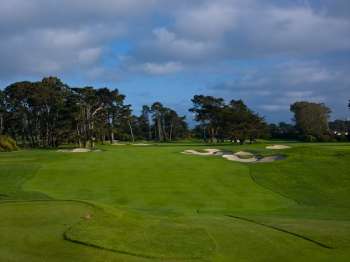One of the most exclusive clubs in America, the San Francisco Golf Club was formed toward the end of the 19th century, however golfing did not begin on its present A.W. Tillinghast layout until 1915. Located a few miles south of the Golden Gate Bridge, the Tillinghast course was a landmark in this country, as it was not only the legendary architect’s first great piece of work, but also the first course of real quality anywhere on the West Coast.
Built across rolling pine-covered ground close to Lake Merced, the course is best recommended for its wonderfully creative design style and a property that features ravines and an array of interesting internal golf undulations. One particular ravine was the scene of the last legal duel in American history, when a California Supreme Court Justice shot and killed a United States Senator in 1859. Within this valley lies the club’s renowned drop-shot par three 7th, appropriately labeled the “Duel Hole” and apparently Tillie’s favorite among the many hundreds of holes he created.
While the present layout is certainly faithful to the original design, that wasn’t the case in the late 1990s. At that time the club had problems with intruding trees and the loss of Tillinghast’s greens and jagged bunker shapes, which had become rounded and more uniform over the years. Worst of all, three of his back nine holes had been redesigned during the 1950s to play away from a road built along part of the club’s boundary. Thankfully a substantial restoration program has returned green, bunker and tee shapes back to their original proportions and rebuilt the three lost holes. Hundreds of trees were also pulled down, which not only opened up lovely vistas across the entire site but reintroduced golfers to the wind.
Thanks to this sensible restoration project, San Francisco members are once again custodians of an important, and much cherished, golf course. Although the front nine features the most dramatic landforms, green contours across the entire layout are brilliantly conceived, while the fairways tend to head through boldly bunkered valleys, swing around sprawling traps or be routed along the edge of the ravines. The bunkering is a feature throughout; the artistically shaped traps cleverly conceived to frame holes or align golfers away from ideal landing areas.
Picking out highlights here is a hard task, because even the flattest fairways are bunkered to present clear and intriguing strategic options and angles. The most obvious highlight is the aforementioned 7th, a great par three dropping toward a small kidney-shaped green that falls on the right and is protected by sand on the left. Continuing down the valley and rising into a steeply leaning green, the 8th is also outstanding, as is the restored par three 13th and the gorgeous three-shotters that conclude each of the nines.
Although Tillinghast is renowned for the variety of his design work, there is something refreshingly unique about this club that sets it apart from many of the gems he created on the East Coast. Hidden to all but the fortunate few, San Francisco Golf Club is not only one of the golfing standouts in the Bay Area, but among the top classic layouts anywhere in the country.

 this course also has exceptional:
this course also has exceptional:

